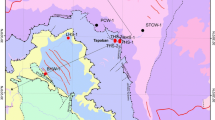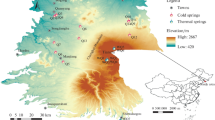Abstract
The mineral scaling problems in the Kızıldere geothermal field along with hydrogeological and geochemical properties of this field were studied. In this content, chemical analyses for 26 water samples from 12 water points and an additional seven geochemical analyses and six XRD analyses of the scale samples were performed. Measured reservoir temperatures of wells vary from 196 (in the well KD-13) to 242 °C (in the well R-1). Geothermal reservoir waters show the water types of Na–HCO3 and Na–HCO3–SO4. Estimated mineral saturations suggest that calcite, aragonite, strontianite, dolomite, amorphous silica, and barite are likely to precipitate as scales. These are confirmed by the results of the geochemical and XRD data of the scale samples. Reservoir chemistry calculations show a fluid richer in steam and acid gases with lower concentrations in the nonvolatile constituents (i.e., Cl, SiO2, Na, etc.) at the reservoir. Geochemical modeling shows that CaCO3 (calcite and aragonite) and strontianite precipitations are inevitable for production and re-injection wells and surface equipment. Amorphous silica scaling is the important risk of re-injection wells. Precipitations of the minerals barite, anhydrite, dolomite, and celestite are also possible. Determinations of the scaling minerals and the safety temperatures to avoid or minimize the scaling problem are the most important parts of this study. It was concluded that cold injection (<50 °C) is favored or inhibitors should be used if any mineral deposition is to be prevented or reduced in injection wells.









Similar content being viewed by others
References
Aksoy N (2014) Power generation from geothermal resources in Turkey. Renew Energy 68:595–601
Alçiçek H, Varol B, Özkul M (2007) Sedimentary facies, depositional environments and palaeogeographic evolution of the Neogene Denizli Basin of SW Anatolia, Turkey. Sediment Geol 202:596–637
APHA (2005) American Public Health Association. American Water Works Association and Water Environment Federation. Standard methods for the examination of water and wastewater, 21st edn. APHA Press, Washington DC
Ariturk S, Parlaktuna M (2001) Estimation of silica scaling temperatures of Kızıldere geothermal field effluent, Turkey. Energy Sour 23:529–539
Arnórsson S (1989) Deposition of calcium carbonate minerals from geothermal waters-theoretical considerations. Geothermics 18:33–39
Arnórsson S (1995) Scaling problems and treatment of separated water before injection. In: WGC-95, book of course on injection technology, Italy pp 65–77
Arnórsson S (2000) Isotopic and chemical techniques in geothermal exploration, development and use: sampling methods, data handling, interpretation. IAEA, Vienna
Arnórsson S, Sigurdsson S, Svavarsson H (1982) The chemistry of geothermal waters in Iceland I. Calculation of aqueous speciation from 0 to 370°C. Geochim Cosmochim Acta 46:1513–1532
Baba A, Ármannsson H (2006) Environmental impact of the utilization of a geothermal area in Turkey. Energy Sour 1:267–278
Baba A, Sözbilir H (2012) Source of arsenic based on geological and hydrogeochemical properties of geothermal systems in Western Turkey. Chem Geol 334:364–377
Bjarnason JO (1994) The speciation program WATCH, version 2.1. Orkustofnun, Reykjavik, p 7
Calmbach L (1997) AquaChem computer code-version 3.7.42. Waterloo hydrogeologic, Waterloo, p 7
Filiz S (1984) Investigation of the important geothermal areas by using C, H, O isotopes. In: Seminar on utilization of geothermal energy for electric power production and space heating, UN Economic Commission for Europe, EP/SEM.9/R.3, Florence, Italy pp 1–13
Gemici U, Tarcan G (2001) Hydrogeochemistry of the Saraycik geothermal area (Manisa), Western Turkey. In: Cidu (ed), Proceedings of the water–rock interaction (WRI-10), Swets & Zeitlinger, Lisse, pp 831–834, ISBN 90 2651 824
Gemici Ü, Tarcan G (2002a) Hydrogeochemistry of Simav geothermal field, western Anatolia, Turkey. J Volcanol Geoth Res 116:215–233
Gemici Ü, Tarcan G (2002b) Distribution of boron in thermal waters of Western Anatolia, Turkey and examples on their environmental impacts. Environ Geol 43:87–98
Gemici Ü, Tarcan G (2004) Hydrogeological and hydrogeochemical features of the Heybeli Spa, Afyon, Turkey: arsenic and the other contaminants in the thermal waters. Bull Environ Contam Toxicol 72:1107–1114
Gemici Ü, Tarcan G (2007) Hydrogeochemistry of the Hisarköy geothermal area (Balıkesir) Western Turkey. In: Water-rock interaction (WRI-12), proceedings of the 12th international symposium on water-rock interaction, pp 203–206
Giese LB (1997) Geotechnische und umwelt geologische aspekte bei der forderung und reinjection von thermal fluiden zur nutzung geothermischer energie am beispiel des geothermal feldes Kızıldere und des umfeldes, W-Anatolien/Turkei (In German). Ph.D. thesis FU Berlin
Giese LB, Pekdeğer A, Dahms E (1998) Thermal fluids and scalings in the geothermal power plant of Kızıldere, Turkey. In: Arehart and Hulston (eds) Water-rock interaction (WRI-9), proceedings of the 9th international symposium on water-rock interaction Taupo, New Zealand. Balcema, Rotterdam, pp 625–628
Gökgöz A (1998) Geochemistry of the Kızıldere-Tekkehamam-Buldan-Pamukkale geothermal fields, Turkey. Geothermal training in Iceland, United Nations university programme, Orkustofnun, Reykjavik, Iceland. Book of reports, pp 115–156
Gökgöz A, Tarcan G (2006) Mineral equilibria and geothermometry of the Dalaman-Köyceğiz thermal springs, southern Turkey. Appl Geochem 21:253–268
Güleç N (1988) He-3 distribution in western Turkey. Bull Miner Res Explor Inst Turkey 108:35–42
Haklıdır FST, Kindap A (2013) The first discovered high entalphy geothermal field in Büyük Menderes Graben: Kızıldere geothermal field with new 80 MWe power plant investment in Western Anatolia, Turkey. In: Proceedings of European geothermal congress, Pisa, Italy, pp 1–3
IAH (1979) Map of mineral and thermal water of Europe. Scale 1:500.000. International Association of Hydrogeologists, Paris, France
Karakuş H, Şimşek Ş (2013) Tracing deep thermal water circulation systems in the E-W trending Büyük Menderes Graben, western Turkey. J Volcanol Geotherm Res 252:38–52
Karamanderesi İH, Helvacı C (2003) Geology and hydrothermal alteration of the Aydın-Salavatlı geothermal field, western Anatolia, Turkey. Turk J Earth Sci 12:175–198
Kindap A, Kaya T, Haklıdır FST, Bükülmez AA (2010) Privatization of Kızıldere geothermal power plant and new approaches for field and plant. In: Proceedings of world geothermal congress (WGC-2010), Bali, Indonesia, pp 1–4
Líndal B, Kristmannsdóttir H (1989) The scaling properties of the effluent water from Kızıldere power station, Turkey, and recommendation for a pilot plant in view of district heating applications. Geothermics 18:217–223
Möller P, Dulski P, Özgür N (2007) Partitioning rare earths and some major elements in the Kizildere geothermal field, Turkey. Geothermics 37:132–156
Mutlu H, Güleç N (1998) Hydrogeochemical outline of thermal waters and geothermometry applications in Anatolia (Turkey). J Volcanol Geotherm Res 85:495–515
Mutlu H, Güleç N, Hilton DR (2008) Helium–carbon relationships in geothermal fluids of western Anatolia, Turkey. Chem Geol 247:305–321
Özgür N (2002) Geochemical signature of the Kizildere Geothermal Field, Western Anatolia, Turkey. Int Geol Rev 44:153–163
Özgür N, Graf W, Stichler W, Wolf M (2004) Origin of the high sulfate contents in thermal waters of Kizildere and environs, Western Anatolia, Turkey. In: Proceedings of international symposium on Eastern Mediterranean geology, Thessaloniki, Greece, pp 1306–1309
Parkhurst DL, Appelo CAJ (1999) User’s guide to PHREEQC (version 2) a computer program for speciation, batch-reaction, one-dimensional transport, and inverse geochemical calculations: U.S. geological survey water-resources investigations report 99-4259, pp 1–312
Şamilgil E, Arda O (1977) Laboratory analyses result of scale sample in Kızıldere (In Turkish). MTA report No: 9527, pp 1–8
Satman A, Uğur Z, Onur M (1999) The effects of calcite deposition on geothermal well inflow performance. Geothermics 28:425–444
Şimşek Ş (1985) Geothermal model of Denizli-Saraykoy-Buldan area. Geothermics 14:393–417
Şimşek Ş (2003) Hydrogeological and isotopic survey of geothermal fields in the Büyük Menderes graben, Turkey. Geothermics 32:669–678
Şimşek Ş, Günay G, Elhatip H, Ekmekçi M (2000) Environmental protection of geothermal waters and travertines at Pamukkale, Turkey. Geothermics 29:557–572
Şimşek Ş, Yıldırım N, Gülgör A (2005) Developmental and environmental effects of the Kızıldere geothermal power project Turkey. Geothermics 34:239–256
Tarcan G (2001) Aquifer chemistry and mineral saturation in selected high temperature geothermal areas. United Nations University Geothermal Training Programme, Orkustofnun, Reykjavik, Iceland. Book of reports, pp 267–290
Tarcan G (2005) Mineral saturation and scaling tendencies of waters discharged from wells (>150°C) in geothermal areas of Turkey. J Volcanol Geotherm Res 142:263–283
Tarcan G, Gemici U (2001) Hydrogeochemistry of the Gumuskoy and Sazlikoy geothermal fields, Aydin, Turkey. In: Cidu-Italy (ed) Proceedings of the water-rock interaction 2001, Swets & Zeitlinger, Lisse, pp 2:931–934, ISBN 90 2651 824
Tarcan G, Gemici Ü (2003) Water geochemistry of the Seferihisar geothermal area, İzmir, Turkey. J Volcanol Geotherm Res 126:225–242
Tarcan G, Gemici Ü (2005) Effects of the contaminants from Turgutlu-Urganlı thermomineral waters on the cold ground and surface waters. Bull Environ Contam Toxicol 74:485–492
Tarcan G, Gemici Ü, Aksoy N (2005) Hydrogeological and geochemical assessments of the Gediz Graben geothermal areas, western Anatolia, Turkey. Environ Geol 47:523–534
Tarcan G, Gemici Ü, Aksoy N (2009) Hydrogeochemical factors effecting the scaling problem in Balçova geothermal field, İzmir, Turkey. Environ Geol 58:1375–1386
Vengosh A, Helvacı C, Karamanderesi İH (2002) Geochemical constraints for the origin of thermal waters from western Turkey. Appl Geochem 17:163–183
Yıldırım N (1989) Scaling problem in the geothermal fields of Turkey and its alternative solution. In: UN seminar on new developments in geothermal energy EP/SEM.14/R.23, Ankara, pp 1–13
Yıldırım N (1997) Corrosion and scaling of low-temperature geothermal fluid. In: International summer school on direct application of geothermal energy; geothermal district heating schemes, İzmir-Çeşme, Turkey. pp 9–19
Yıldırım N, Güner İN (2005) Geochemical properties and determination of turn over time by using 14C isotope. Kızıldere and Tekkehamam geothermal field of Turkey. World Geothermal Congress, Antalya, pp 1–6
Yıldırım N, Şimşek Ş (2003) Determination of appropriate injection conditions for Kızıldere geothermal waste fluid to avoid scale formation and cooling. European geothermal conference, 25–30 May Szeged, Hungary
Acknowledgments
The TÜBİTAK (The Scientific and Technical Research Council of Turkey) Research Fund financially supported this research (Project Number: 109Y315). Special thanks go to the authorities and project teams of the Zorlu Energy for permission to publish this study. The authors would like to thank anonymous reviewer for helpful remarks.
Author information
Authors and Affiliations
Corresponding author
Rights and permissions
About this article
Cite this article
Tarcan, G., Özen, T., Gemici, Ü. et al. Geochemical assessment of mineral scaling in Kızıldere geothermal field, Turkey. Environ Earth Sci 75, 1317 (2016). https://doi.org/10.1007/s12665-016-6112-5
Received:
Accepted:
Published:
DOI: https://doi.org/10.1007/s12665-016-6112-5




